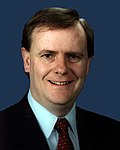| | ||||||||||||||||
| ||||||||||||||||
| ||||||||||||||||
| ||||||||||||||||
A leadership spill of the federal parliamentary leader of the Liberal Party of Australia was held on 23 May 1994. The incumbent, John Hewson, was defeated by Alexander Downer in a vote of Liberal Party Members of Parliament (MPs) by 43 votes to 36 votes. [1] Downer thus became the Leader of the Opposition in the Parliament of Australia.



